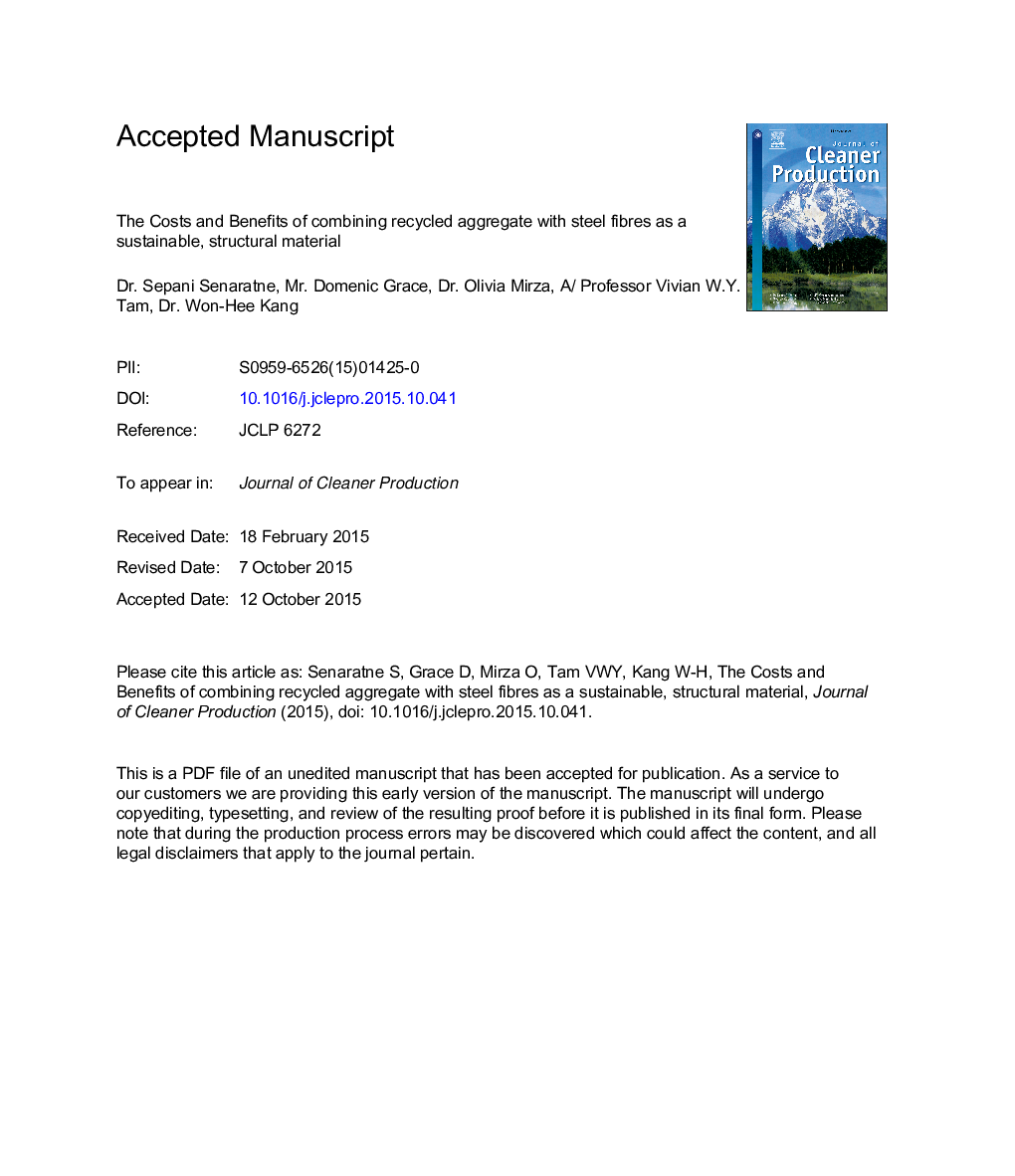| کد مقاله | کد نشریه | سال انتشار | مقاله انگلیسی | نسخه تمام متن |
|---|---|---|---|---|
| 10687822 | 1017962 | 2016 | 37 صفحه PDF | دانلود رایگان |
عنوان انگلیسی مقاله ISI
The costs and benefits of combining recycled aggregate with steel fibres as a sustainable, structural material
ترجمه فارسی عنوان
هزینه ها و مزایای ترکیب ترکیبات بازیافت شده با الیاف فولادی به عنوان مواد پایدار ساختاری
دانلود مقاله + سفارش ترجمه
دانلود مقاله ISI انگلیسی
رایگان برای ایرانیان
کلمات کلیدی
بازیافت، بتن، الیاف فولادی، پایداری، تجزیه و تحلیل سود و زیان،
ترجمه چکیده
بیش از 26.8 میلیارد تن بتن معمولی در هر سال مورد استفاده قرار می گیرد که به نوبه خود باعث ایجاد مقدار قابل توجهی زباله های ساخت و ساز و تخریب می شود. گرچه ترکیب جامدات به عنوان یک ماده پایدار که راه حل های این مشکل را ارائه می دهد به خوبی شناخته شده است، از لحاظ خواص ساختاری آن به عنوان سنگ معدن بدست می آید. با اضافه کردن فیبر فولادی به جمع آوری بازیافت، می توان یک ماده ساختاری صحیح به دست آورد. اما اثربخشی هزینه ترکیب ترکیبی، در مقایسه با ترکیب طبیعی، ناشناخته است. این پژوهش با هدف بررسی اثربخشی مصارف بازیافتی و فیبر فولادی در ترکیب مطلوب آن برای پرتو ثانویه انجام شده است. در مرحله اول، یک مطالعه تجربی برای تعیین ترکیب مطلوب انجام شد که با استفاده از آن تجزیه و تحلیل سود هزینه ای و هزینه های مستقیم و غیرمستقیم جمع آوری گردید. مصاحبه با تمرینکنندگان 6 کارخانه بازیافت در سیدنی انجام شد. ترکیبی بهینه که از طریق آزمایش به دست آمد، 30٪ جایگزینی جامد بازیافت شده با افزودن فیبر فولادی 0.6٪ بود. تجزیه و تحلیل سود هزینه نشان داد که صرفه جویی در هر پرتو به علت جایگزینی جمع آوری بازیافت تقریبا 2.5 برابر بیشتر در مقایسه با افزایش هزینه با توجه به اضافه کردن فیبر فولاد در طراحی پرتو مورد نظر است. این نتایج تایید کرد که افزایش مزایای استفاده از فیبر فولاد می تواند به طور قابل ملاحظه ای با مزایای پایدار شمارش جامد بازیافت شده در مخلوط مطلوب جبران شود. تحقیقاتی که در این مقاله انجام شده است از لحاظ علمی با توجه به معرفی یک ماده ساختاری جدید که دارای مزایای قابل توجه پایدار و هزینه است، از لحاظ علمی قابل توجه است. این مطالعه توصیه هایی را برای تمام طرف های ذینفع در فرایندهای جمع آوری شده بازیافتی مانند سیاست گذاران، تاسیسات بازیافت، سازندگان، مشتریان و طراحان برای ترویج این مواد جدید ارائه می دهد.
موضوعات مرتبط
مهندسی و علوم پایه
مهندسی انرژی
انرژی های تجدید پذیر، توسعه پایدار و محیط زیست
چکیده انگلیسی
More than 26.8 billion tonnes of normal concrete is used globally every year, which in turn creates an overwhelming amount of construction and demolition waste. Although recycled aggregate is well recognised as a sustainable material that offers solutions to this problem, it is regarded as inferior to natural aggregate in terms of its structural properties. By adding steel fibre to recycled aggregate, a structurally sound material can be obtained. But the cost effectiveness of the optimum combination, when compared to natural aggregate, is unknown. This research aims to analyse the cost effectiveness of recycled aggregate and steel fibre in its optimum combination for a secondary beam. Firstly, an experimental study was conducted to determine the optimum combination, which was followed by a cost benefit analysis to discover the direct/indirect costs and benefits of recycled aggregate. Interviews were undertaken with practitioners of six recycling plants in Sydney. The optimum combination found through the experiment was 30% recycled aggregate replacement with the addition of 0.6% steel fibre. The cost benefit analysis showed that the savings per beam due to recycled aggregate replacement was nearly 2.5 times high when compared to the cost increase due to steel fibre addition in the considered typical beam design. These results confirmed that the additional cost increase of utilising steel fibre could be offset considerably by the quantified sustainable benefits of recycled aggregate in the optimum mixture. The research reported in the paper is scientifically significant due to the introduction of a new structural material, which has considerable sustainable and cost benefits. This study offers recommendations for all parties concerned in recycled aggregate processes such as policy makers, recycling facilities, builders, clients and designers to promote this new material.
ناشر
Database: Elsevier - ScienceDirect (ساینس دایرکت)
Journal: Journal of Cleaner Production - Volume 112, Part 4, 20 January 2016, Pages 2318-2327
Journal: Journal of Cleaner Production - Volume 112, Part 4, 20 January 2016, Pages 2318-2327
نویسندگان
Sepani Senaratne, Domenic Gerace, Olivia Mirza, Vivian W.Y. Tam, Won-Hee Kang,
